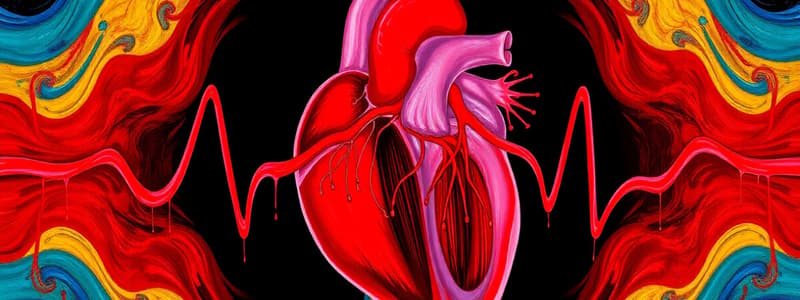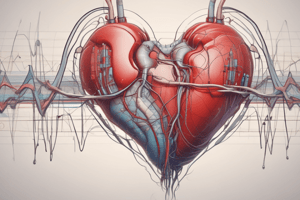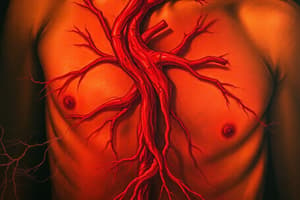Podcast
Questions and Answers
Which factor does NOT influence stroke volume (SV)?
Which factor does NOT influence stroke volume (SV)?
- Heart rate (correct)
- Contractility
- Preload
- Afterload
What condition is least likely to lead to reduced blood pressure through decreased cardiac output?
What condition is least likely to lead to reduced blood pressure through decreased cardiac output?
- Myocardial infarction
- Intractable diarrhea
- Increased fluid intake (correct)
- Heat stroke
What is the target mean arterial pressure (MAP) often aimed for in cases of shock?
What is the target mean arterial pressure (MAP) often aimed for in cases of shock?
- 50 mm Hg
- 80 mm Hg
- 65 mm Hg (correct)
- 70 mm Hg
Why is body surface area (BSA) preferred over body weight for adjusting hemodynamic measurements?
Why is body surface area (BSA) preferred over body weight for adjusting hemodynamic measurements?
Which condition is associated with a reduction in systemic vascular resistance (SVR)?
Which condition is associated with a reduction in systemic vascular resistance (SVR)?
What is the primary purpose of Mean Arterial Pressure (MAP)?
What is the primary purpose of Mean Arterial Pressure (MAP)?
Which formula correctly represents the calculation of Mean Arterial Pressure (MAP)?
Which formula correctly represents the calculation of Mean Arterial Pressure (MAP)?
What does the variable CO represent in the context of blood circulation?
What does the variable CO represent in the context of blood circulation?
Why is the calculation of MAP not advised in the ICU setting?
Why is the calculation of MAP not advised in the ICU setting?
Which statement best describes shock?
Which statement best describes shock?
According to the content, what does the formula MAP = CO x SVR imply?
According to the content, what does the formula MAP = CO x SVR imply?
What leads to cell death during advanced stages of shock?
What leads to cell death during advanced stages of shock?
Which of the following types of shock is caused by an obstruction of circulation?
Which of the following types of shock is caused by an obstruction of circulation?
How does systemic inflammatory response syndrome (SIRS) typically manifest?
How does systemic inflammatory response syndrome (SIRS) typically manifest?
Which measurement is NOT used to evaluate cardiac performance?
Which measurement is NOT used to evaluate cardiac performance?
What is the primary consequence of untreated shock?
What is the primary consequence of untreated shock?
What common mechanism leads to the various types of shock?
What common mechanism leads to the various types of shock?
As shock progresses, how do the characteristics of different shock subtypes change?
As shock progresses, how do the characteristics of different shock subtypes change?
What is the hallmark characteristic of septic shock?
What is the hallmark characteristic of septic shock?
Which finding is essential for the diagnosis of shock?
Which finding is essential for the diagnosis of shock?
Which of the following is NOT a typical symptom of shock?
Which of the following is NOT a typical symptom of shock?
Why is hemodynamic monitoring important in the management of shock?
Why is hemodynamic monitoring important in the management of shock?
How is the pressure measurement during balloon inflation related to cardiac assessment?
How is the pressure measurement during balloon inflation related to cardiac assessment?
In critically ill septic patients, what is commonly observed initially regarding SVO2 values?
In critically ill septic patients, what is commonly observed initially regarding SVO2 values?
What effect does increased capillary permeability have in SIRS?
What effect does increased capillary permeability have in SIRS?
Which of the following is often described as a hallmark of shock, but may not be present in all patients?
Which of the following is often described as a hallmark of shock, but may not be present in all patients?
Study Notes
Hemodynamics
- The study of blood movement and the forces involved in blood circulation.
- Arterial blood pressure is the force exerted by blood on vessel walls.
- Systolic blood pressure: The peak pressure during ventricular contraction
- Diastolic blood pressure: The minimum pressure during ventricular relaxation
- Mean arterial pressure (MAP) is the average pressure during the cardiac cycle, crucial for organ perfusion
- MAP calculation: Typically approximated as 1/3 SBP + 2/3 DBP, but this formula may not be accurate in critically ill patients
- MAP = CO x SVR (Cardiac Output x Systemic Vascular Resistance)
Cardiac Output (CO)
- CO is the volume of blood pumped per minute.
- Derived from the product of stroke volume (SV) and heart rate (HR): CO = SV x HR
- Stroke volume is the volume of blood ejected from the left ventricle each heartbeat
- SV is influenced by preload (blood available for ejection), afterload (resistance to ejection), and contractility (heart's force generation)
Shock
- A syndrome of impaired tissue perfusion, often accompanied by hypotension
- Leads to cellular dysfunction, organ damage and ultimately death if not addressed
- Types of shock: Hypovolemic, obstructive, cardiogenic, distributive (sepsis)
- Treatment varies depending on the underlying cause
Causes of Shock
- Reduction of intravascular volume (Hypovolemic: blood loss, dehydration)
- Circulation obstruction (Obstructive: pulmonary embolism, pericardial tamponade)
- Myocardial pump failure (Cardiogenic: heart attack, heart failure)
- Increased vascular capacitance (Distributive: sepsis, anaphylaxis)
Advanced Shock
- Different subtypes of shock become difficult to distinguish in advanced stages, as compensatory mechanisms fail
- Clinical features of advanced shock become similar across different types
- Multiple types of shock can coexist in a single patient
Cellular Effects of Shock
- Ischemia, inflammation, and oxygen radical generation contribute to cellular damage
- During prolonged periods of ischemia, cells switch to anaerobic metabolism, depleting ATP stores
- Lactic acid and toxins accumulate, impairing mitochondrial function
- This leads to cell death if prolonged
- Irreversible cellular damage in advanced shock results in multiple organ dysfunction syndrome (MODS)
Systemic Inflammatory Response Syndrome (SIRS)
- A generalized inflammatory response to various insults, including shock, infection, trauma, and injury
- Hallmarks of SIRS include profound vasodilation (decreased perfusion) and increased capillary permeability (fluid leakage from vessels)
- SIRS is common in hypovolemic shock and septic shock, less frequent in cardiogenic shock
- Clinical features of SIRS involve impaired perfusion and reduced intravascular volume
Shock Diagnosis
- Confirmed through physical examination findings of impaired tissue perfusion
- Hemodynamic and laboratory changes consistent with impaired perfusion
- Hypotension is a common symptom, but not always present in all patients
- Hemodynamic monitoring is crucial for determining the type of shock and response to treatment
Systemic Vascular Resistance (SVR)
- The resistance the heart encounters while pumping blood
- Measured using a pulmonary artery catheter
- Influenced by vasoconstriction (increased resistance) and vasodilation (decreased resistance)
- Values are generally adjusted for body surface area (BSA)
Cardiac Index (CI)
- Cardiac output adjusted for body surface area
- Measures the effectiveness of the heart in terms of blood pumping relative to size
Stroke Index (SI)
- Stroke volume adjusted for body surface area
- Reflects the efficiency of ventricular contraction per unit of body size
Systemic Vascular Resistance Index (SVRI)
- Systemic vascular resistance adjusted for body surface area
- Represents the total resistance to blood flow throughout the circulatory system relative to body size
Pulmonary Artery Wedge Pressure (PAWP)
- Reflects left atrial pressure
- Measured by inflating a balloon catheter that wedges into a small pulmonary artery branch
- Provides information about left ventricular filling pressure and left ventricular function
Mixed Venous Oxygen Saturation (SVO2)
- Saturation of oxygen in mixed venous blood
- Measured using a pulmonary artery catheter
- Indicator of oxygen delivery and tissue oxygen consumption
- Lower values reflect reduced oxygen delivery or increased oxygen consumption, indicating potential tissue hypoxia
Studying That Suits You
Use AI to generate personalized quizzes and flashcards to suit your learning preferences.
Related Documents
Description
Explore the fundamental concepts of hemodynamics and cardiac output through this quiz. Understand key terms like arterial blood pressure, mean arterial pressure, and the factors influencing stroke volume. Test your knowledge on the dynamics of blood circulation and its importance to organ perfusion.




